Exploring the Al Mulla Building: A Deep Dive
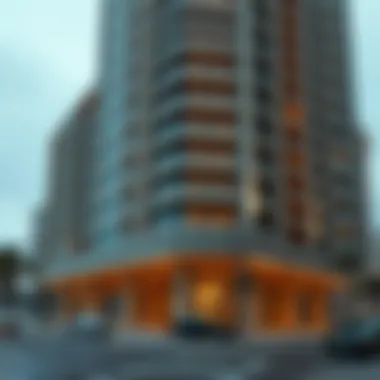
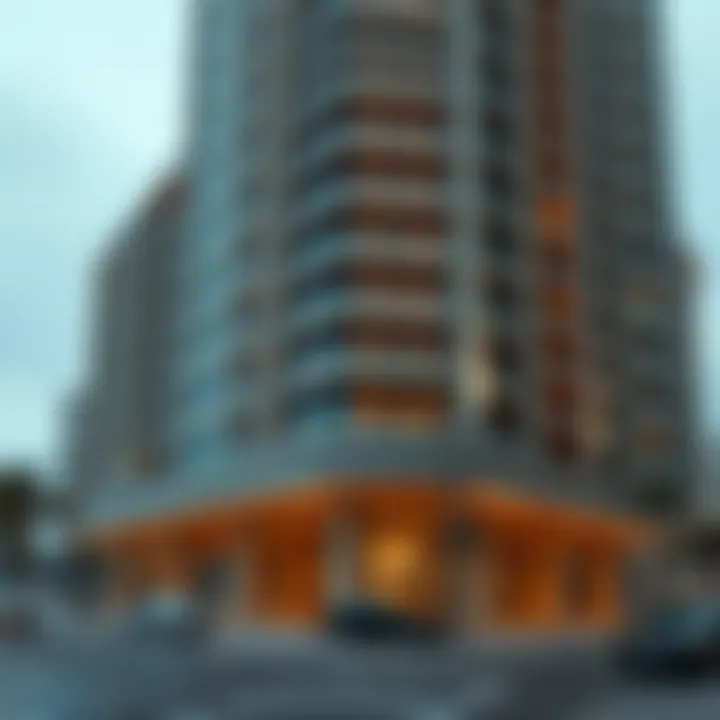
Intro
The Al Mulla Building, a striking feature in Dubai's skyline, encapsulates a blend of history and modernity. As you walk through its halls or view it from a distance, it's hard not to appreciate the architectural prowess and the cultural significance it carries. This landmark doesn't just serve as a structure of bricks and mortar, but rather as a testament to Dubai's relentless growth and ambition.
Inside these walls, one finds a microcosm of the city itself—where old-world charm meets rapid innovation. From its intricate design details to the bustling businesses housed within, the Al Mulla Building offers a unique lens through which to explore Dubai’s development narrative. By delving into its history, design elements, and investment potential, one can better appreciate the Al Mulla Building’s role not just in the real estate market, but in the cultural tapestry of Dubai.
As we embark on this comprehensive investigation, we’ll cover the various aspects of the building that make it a focal point for not only architectural enthusiasts but also savvy investors looking to navigate the Dubai real estate scene.
Market Trends
To understand the significance of the Al Mulla Building, one must first grasp the current real estate landscape in Dubai.
Current Real Estate Pricing
Right now, the market is buzzing with activity. Prices are on a rollercoaster, driving both interest and investment. While some sectors are cooling off, areas around landmark buildings like Al Mulla witness sustained interest. The average price per square foot in the vicinity has shown resilience, often valued higher compared to other locations.
For instance:
- Premium office spaces in the area are trending towards AED 2,000 per square meter.
- Residential units vary significantly, but luxury apartments can easily fetch around AED 1,600 per square meter.
This pricing trend is crucial for potential buyers or investors looking into rental yields or appreciation in value.
Emerging Neighborhoods and Developments
Surrounding the Al Mulla Building, new neighborhoods are sprouting like mushrooms after rain. Areas like Business Bay and Dubai Marina are evolving with additional commercial hubs and residential projects, which could further boost property values. The linkages between these areas and the Al Mulla Building invite potential for growth.
Moreover, the development of leisure facilities and improved public transportation options make these neighborhoods increasingly attractive. This harmonious blend of amenities and location is a siren call for both businesses and homebuyers.
Investment Opportunities
For investors, navigating the landscape around the Al Mulla Building offers a plethora of opportunities, whether short-term or long-term.
Short-Term vs Long-Term Investment Strategies
When considering investing in properties in this area, one must evaluate the potential return on investment based on individual goals.
- Short-Term Investments: These could be geared towards quick flippers who look to capitalize on rising property values. Suitable for trend-followers, these investors tend to prioritize resale and fast profits.
- Long-Term Investments: Those looking for longevity may focus on properties within a bit of a buffer zone. With the evolving market, investing here may yield considerable returns as surrounding developments continue to rise.
Ultimately, your strategy should align with market trends, personal risk tolerance, and financial objectives.
Financing and Mortgage Options
Navigating financing can feel like trying to find your way through a maze. However, understanding available mortgage options is essential for making informed decisions. Major banks such as Emirates NBD and Abu Dhabi Commercial Bank offer a range of products to suit different financial backgrounds.
- Fixed-rate Mortgages: Ideal for those who prefer stable payments over time.
- Variable-rate Mortgages: These can be riskier but may yield lower rates in some situations.
Investors should carefully assess the terms and conditions of each option to ensure they are making a prudent choice for their financial health.
"The Al Mulla Building isn’t just about walls; it’s about what goes behind those walls—the businesses, the life, and the dreams of those who inhabit it."
As we uncover the multifaceted aspects of the Al Mulla Building, it becomes clear that both its historical significance and market relevance provide fertile ground for a deep dive into the future of Dubai's real estate landscape.
For more insights, refer to resources like Wikipedia, Britannica, and property databases on Reddit. Get ready to explore.
Prelude to the Al Mulla Building
The Al Mulla Building serves as a beacon of architectural and cultural significance in Dubai, embodying the city's ever-evolving urban landscape. This structure is not just a building; it is a piece of history intertwined with the narrative of Dubai's transformational journey from a modest trading hub to a cosmopolitan metropolis. Exploring its intricacies is pivotal for anyone seeking to understand the multifaceted development of Dubai as both a modern marvel and a custodian of tradition.
Within the context of urban development, the Al Mulla Building's strategic location and design reflect the aspirations of a city that constantly seeks to push boundaries. When one delves into the building's architectural features, it becomes evident how they align with Dubai's broader goals of economic growth, sustainability, and community engagement. Furthermore, understanding the importance of this structure in its historical context offers insights into the preservation of cultural heritage amid rapid modernization, shedding light on how the past influences contemporary society.
Context within Dubai's Urban Development
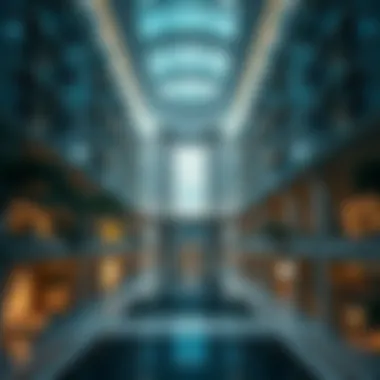
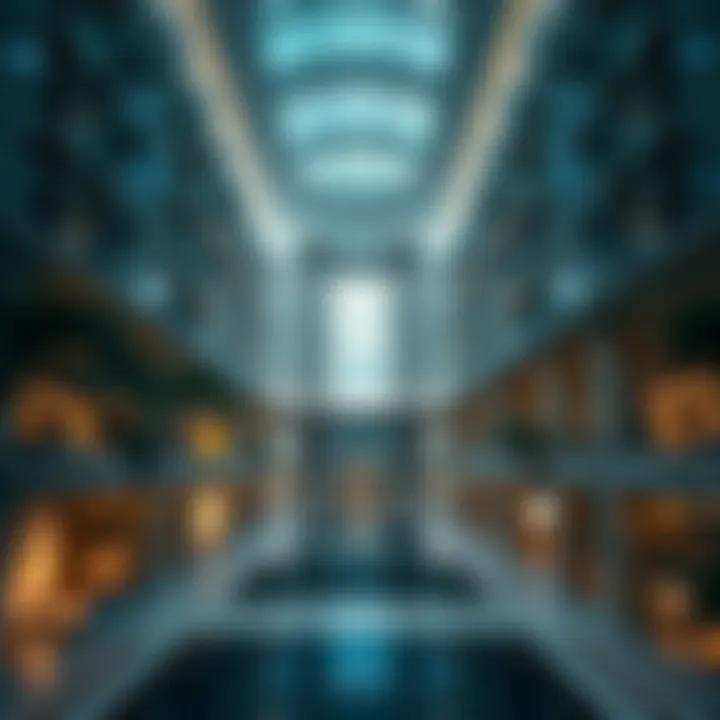
The Al Mulla Building is often regarded as a cornerstone in Dubai’s urban planning vision that dates back several decades. Located in a bustling area, its presence signifies not just a physical structure but a representation of the development strategies that have shaped the emirate. Over the years, Dubai has transitioned into a global hub for trade, business, and tourism, and buildings like Al Mulla have played a vital role in this transformation.
Its design is reflective of both functionality and aesthetics, ensuring it fits seamlessly within the urban fabric. Key transport networks and commercial centers are just a stone's throw away, making it a vital part of the strategic planning undertaken in Dubai. As the city continues to grow, such buildings become landmarks that connect both residents and visitors to the rich tapestry of Dubai’s growth story.
Importance in Historical Context
Examining the Al Mulla Building through the lens of history yields important insights into its significance over time. In its inception, the building marked a period when Dubai began to experiment with modern architectural styles while still paying homage to traditional values. This duality is crucial, as it reveals not only an evolving style but also the shifting mindset of a society embracing modernity while preserving its roots.
"In the heart of every great city, there lies a story waiting to be told. The Al Mulla Building is no exception."
Throughout the years, the Al Mulla Building has witnessed key historical events that have defined Dubai and the wider region. From economic booms to cultural exchanges, the building stands as a testament to the resilience and spirit of its community. The reflections of these pivotal moments are etched in its walls, making it a silent narrator of the city’s vibrant history.
Understanding these historical dimensions is essential for anyone interested in the cultural journey of Dubai, as it provides an engaging narrative that shapes the experience of both investors and residents. It also highlights the importance of preserving such landmarks as the city looks to the future.
Architectural Features of the Al Mulla Building
The Al Mulla Building is not just any structure; it’s a statement within the vast architectural conversation that Dubai continuously engages in. Its features are a canvas depicting the intersection of modernity and tradition, providing an architectural story that resonates well with both locals and visitors. Understanding these features is essential, especially for those keen on real estate or cultural heritage. The design elements, the materials used, and innovative construction methods come together to form a unique edifice that has much to teach us about urban development in Dubai.
Design Elements
The design of the Al Mulla Building stands out amidst a backdrop of towering skyscrapers. It boasts a blend of functionality and style that caters to commercial needs while providing an aesthetic appeal that catches the eye. For instance, the building showcases a modern facade characterized by smooth lines and geometric shapes, which aligns with contemporary architectural trends. Its layout incorporates expansive glass windows that allow natural light to flood the interior, creating an inviting atmosphere for occupants and visitors alike.
The use of open spaces within the building fosters a sense of community and encourages interaction among tenants. Elements like terraces and balconies further enhance the user experience by offering stunning views of the surrounding urban landscape. Such thoughtful design choices not only elevate the building's aesthetic value but also improve its practicality, making it a sought-after location for businesses and activities.
Materials Used
Materials play a critical role in any construction project, and the Al Mulla Building utilizes high-quality resources that underscore its stature in the city. The predominant use of glass not only reflects the modernist trend but also serves functional purposes, such as thermal insulation and energy conservation. Adjunct materials like steel and reinforced concrete provide strength and durability, allowing the building to withstand both time and the elements.
Furthermore, the choice of environmentally friendly materials aligns with global trends of sustainability. This not only attracts eco-conscious tenants but also contributes positively to lower operational costs, which is significant for investors looking to optimize returns. In many respects, the material choices serve as the backbone of the building, reinforcing its physical and functional integrity.
Innovation in Construction Methods
When it comes to construction, the Al Mulla Building serves as a benchmark for contemporary practices in the region. The methods adopted during its construction reveal a commitment to not just speed but also quality. One standout aspect is the integration of modular construction techniques, which significantly reduce waste and allow for faster completion times. By employing prefabricated elements, the project team minimized onsite disruption while maintaining precision in building standards.
Additionally, smart technology was incorporated into both the design and construction phases. From advanced project management software to real-time monitoring of construction processes, these innovations ensure that quality and efficiency go hand in hand. This proactive approach mitigates risks associated with traditional methods, ultimately contributing to a project that is both timely and respected by investors.
"Innovation in construction methods isn't just about using the latest tools; it's about thinking ahead and combining techniques that lead to sustainable progress."
The architectural features of the Al Mulla Building epitomize what Dubai represents: a city constantly evolving, grounded in its cultural roots while looking toward the future. Each aspect—from the design through material choices to construction methods—tells a part of this vibrant story, making it a crucial point of study for anyone looking to invest in the locale.
Historical Timeline of the Al Mulla Building
The Historical Timeline of the Al Mulla Building provides important context around its construction, redevelopment, and influence within the fabric of Dubai. By examining this timeline, we uncover not just the physical changes to the building but also how it parallels the city’s growth and shifts in real estate dynamics. This section serves to enlighten readers about the Al Mulla Building's evolution and contextualizes the trends in Dubai's urban development.
Inception and Construction
The journey of the Al Mulla Building began in the 1970s, a time when Dubai was on the cusp of transformation. With aspirations to establish itself as a global hub, the city's leadership embarked on ambitious construction projects. The Al Mulla Building was inaugurated in 1978, marking its footprint as one of the earliest skyscrapers in the area, designed to cater to the burgeoning commercial demand.
The architect responsible for its design drew inspiration from modernist principles, blending both form and function to create a structure that wasn’t just aesthetically pleasing but also highly efficient. Upon completion, the building was lauded for its unique design, which not only enhanced the visual landscape of Dubai but also significantly impacted the local economy by attracting businesses and foreign investment.
The location was strategic, situated near vital transport routes, allowing swift access for goods and services. This factor alone helped to solidify the Al Mulla Building's role as a commercial cornerstone within the city.
Key Events Over the Decades
Over the decades, the Al Mulla Building has witnessed and adapted to significant events that shaped Dubai. Here are a few highlights:
- 1980s Boom: During this period, the building saw a surge in occupancy, reflecting Dubai’s economic expansion as it evolved into a commercial powerhouse.
- Renovation Efforts (1990-1992): A renovation was initiated to modernize facilities and infrastructure, aligning with the city’s upscale developments. This upgrade maintained the building's relevance in an ever-evolving market.
- Global Financial Crisis (2008): Like many entities, the Al Mulla Building felt the pinch during the downturn. However, its sturdy infrastructure allowed it to weather this economic storm, remaining resilient while many projects were halted or abandoned.
- Recent Developments: In the last few years, the building has undergone further enhancements, including the addition of green technologies and energy-efficient features, reflecting the current global emphasis on sustainability.
Each of these events plays a role in illustrating the Al Mulla Building's ongoing story—one that's intertwined with the larger narrative of Dubai's development. Through this historical lens, we can better understand not just the structure itself, but also its broader implications on the community and real estate landscape.
"The Al Mulla Building serves as a testament to Dubai’s innovative spirit and resilience over the decades."
As we understand these historical significance and changes, it becomes clear why the Al Mulla Building is not just a physical structure but a landmark of cultural and economic significance for the city.
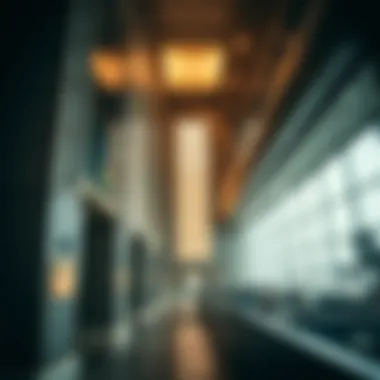
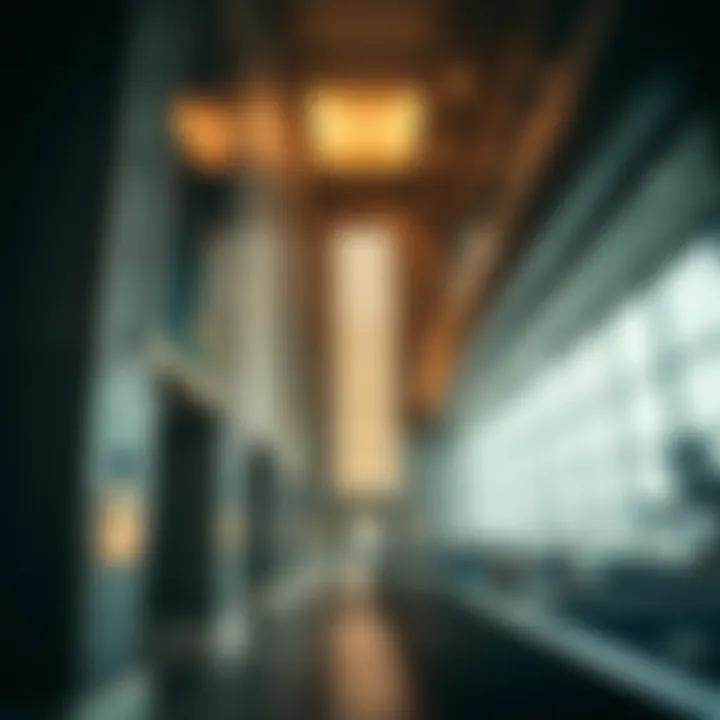
Cultural Significance of the Al Mulla Building
The Al Mulla Building is not just a structure made of concrete and glass; it stands as a testament to the cultural mosaic of Dubai. It embodies the harmonious blend of tradition and modernity, mirroring the evolution of the city itself. Understanding its cultural significance requires examining its role in both preserving heritage and shaping local identity. Within this section, we will delve into how this building represents cultural heritage and the influence it wields in forming the identity of the community around it.
Cultural Heritage Representation
Constructed during a time when Dubai was brushing off its sleepy image to step into the global limelight, the Al Mulla Building showcases elements of traditional Islamic architecture while integrating contemporary design trends. It serves as a canvas, reflecting the narratives and stories that shape the emirate's history. The intricate motifs commonly found in Arabic architecture are echoed in the building, creating a direct dialogue with the past while standing proud among modern skyscrapers.
The location of the Al Mulla Building greatly contributes to its cultural stature. Nestled in a vibrant area, it draws in a diverse audience. The building hosts various cultural events and exhibitions that foster a sense of community. Local artists often showcase their works here, providing a platform for creative expression, which reflects and nurtures the artistic lineage of Dubai.
Residents and expatriates alike stroll past the Al Mulla Building, appreciating its artistic touches and its role in uniting the old with the new. Additionally, many recall childhood stories and connections linked to the site, reinforcing its significance as a community landmark. This intertwining of personal and collective histories deepens the building's cultural importance beyond its architectural splendor.
Influence on Local Identity
Al Mulla Building plays a pivotal role in Dubai’s evolving identity. It stands tall against the backdrop of rapid urbanization, being a symbol of what Dubai was, what it is, and what it aims to be. It functions as both a commercial hub and a community gathering point, affecting the day-to-day lives of those around it.
The conversations that buzz in and around its corridors speak volumes about local aspirations and challenges. As residents and visitors navigate their lives, they often associate their experiences and memories with this landmark. It has become a part of the local psyche, coloring the narratives spoken about the city.
Furthermore, the Al Mulla Building is increasingly becoming a focal point for initiatives that celebrate the emirate's heritage and culture. Various community activities, such as traditional festivals and workshops on crafts, connect diverse groups of people, bridging the gap between newcomers and long-time inhabitants. This fosters a stronger sense of unity while allowing the building to emerge as a cultural beacon.
"The Al Mulla Building serves as a reminder that as we advance technologically, we must also hold onto the roots that define our identity."
In the grand scheme of things, the Al Mulla Building encapsulates the essence of Dubai's journey — a blend of modernity grounded in a rich cultural tapestry. It is more than just a location; it is a narrative woven into the fabric of the community, shaping and adapting alongside the people who call Dubai home.
Current Usage of the Al Mulla Building
The Al Mulla Building serves as more than just a physical structure in Dubai’s skyline. It functions as a vital hub of activities, reflecting the economic dynamism and social vibrancy of the area. Understanding the current usage of the building is crucial for stakeholders like investors, realtors, and community members, who can glean valuable insights from how the space is utilized.
Commercial Ventures
In the heart of Dubai, the Al Mulla Building hosts a variety of commercial ventures that embody the city’s entrepreneurial spirit. The ground floors are bustling with offices and retail outlets that often cater to both local and international clientele. This inherent mix makes it a prime location for businesses seeking visibility and accessibility in a bustling urban environment.
Several established businesses have found their home here. You can find a blend of innovative startups and well-known brands, which reflects the diversity of the consumer market in Dubai. For instance, a popular cafe chain has set its roots in the building, drawing both locals and tourists. The visibility and foot traffic that come with such placements amplify the commercial viability of the Al Mulla Building, making it appealing for prospective investors and entrepreneurs.
Moreover, the building's amenities, including modern meeting rooms and conference facilities, provide an excellent setting for hosting business events. Whether it’s a small gathering or a larger corporate function, the Al Mulla Building's layout accommodates a variety of professional needs. This adaptability enhances its attractiveness to businesses seeking flexible and functional spaces in the competitive Dubai market.
Community Engagement
On another front, the Al Mulla Building plays a significant role in community engagement. The ownership has made strides to foster connections between businesses and the local community. Regular community events are held here, showcasing cultural festivities that invite residents and expatriates alike to partake in Dubai's rich multicultural tapestry.
For example, art exhibitions featuring local artists frequently take place in the foyer, allowing talent to shine and engage with the public. These events not only provide exposure for artists but also create a sense of belonging and identity within the community.
Additionally, organizations frequently collaborate with local nonprofits to hold workshops and educational sessions that bring people together. One local initiative offers free entrepreneurial coaching for aspiring business owners within the community, fostering economic development and engagement. A vibrant community spirit grows roots here, tying together various facets of life in Dubai while promoting inclusivity and cultural exchange.
"The Al Mulla Building stands as a testament to both commercial success and community unity, proving that vibrant connections can flourish in the heart of Dubai."
Overall, the current usage of the Al Mulla Building exemplifies a thriving intersection between business and community, making it a model for other developments in the region. The ongoing evolution of this space allows for continued exploration of its potential, merging economic opportunities with social responsibility in a city that never stops growing.
Location Benefits of the Al Mulla Building
The location of the Al Mulla Building plays a pivotal role in its status as a significant landmark in Dubai. A building's site often influences its attractiveness to investors and businesses alike. This section scrutinizes the location benefits that not only enhance the building's prominence but also substantiate its value in the marketplace.
Accessibility to Major Infrastructure
One of the standout features of the Al Mulla Building is its remarkable accessibility to major infrastructure. Located strategically within the bustling urban fabric of Dubai, it’s a stone's throw from the Sheikh Zayed Road. This thoroughfare is a lifeblood for commercial activities, linking various parts of the emirate seamlessly.
Transport options aplenty surround the Al Mulla Building, including the Dubai Metro. Just a short walk away lies the excellent connectivity provided by the metro, making commutes smoother for countless individuals—be it workers heading to their offices or clients visiting businesses located in the building.
In addition, the proximity to Dubai International Airport cannot be overstated. This airport serves as a global hub, facilitating ease of travel for both local and international visitors. For businesses based in the Al Mulla Building, this means easier access to potential partners and markets, driving prospects for growth and expansion.
Accessibility is a cornerstone of successful urban establishment; the Al Mulla Building exemplifies this principle, positioning itself at a strategic node within the city's transportation network.
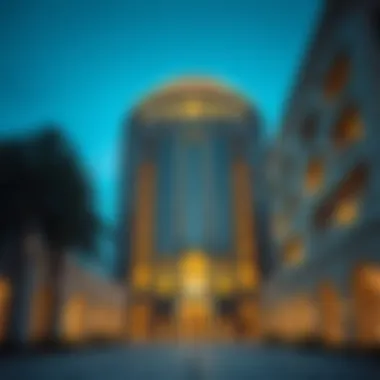
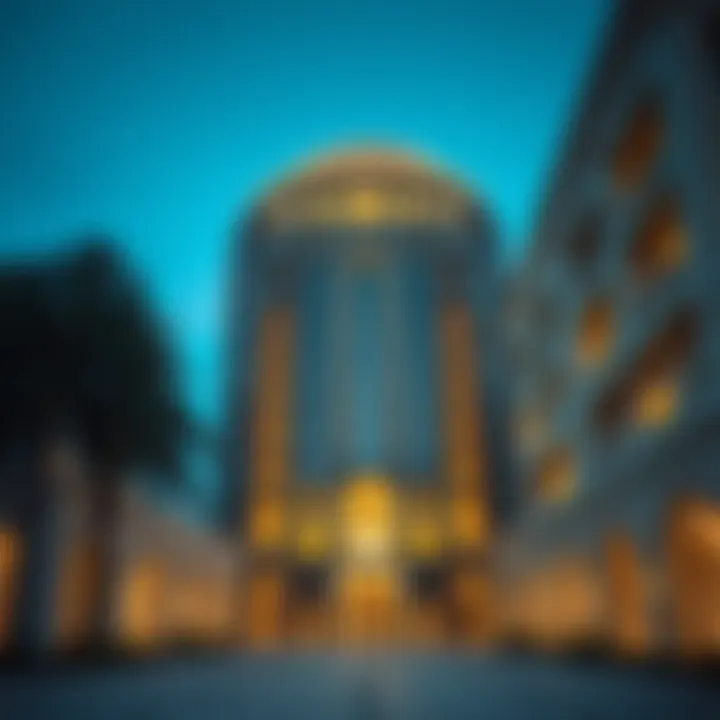
Proximity to Business Hubs and Amenities
The Al Mulla Building also reaps the benefits of being close to prominent business hubs. Its location offers immediate access to various corporate centers, including the Dubai World Trade Centre and Dubai Financial Centre. This proximity fosters a collaborative atmosphere where networking opportunities are plentiful. Busy professionals can easily traverse between major offices, making crucial meetings more convenient.
Moreover, the neighborhood surrounding the Al Mulla Building is peppered with amenities that cater to both work and leisure. Restaurants, cafes, and retail outlets abound, ensuring that daytime workers and evening visitors have enough options to recharge throughout the day. From quick bites to fine dining, the building's vicinity accommodates diverse preferences and budgets.
The allure extends beyond just food and retail. The area typically boasts parks and recreational spaces that provide a breath of fresh air amid the hustle and bustle of city life. All of these factors contribute to a work environment that is flexible and conducive to productivity—and an appealing place for potential tenants to consider.
Investment Potential in the Al Mulla Building
The Al Mulla Building embodies a significant opportunity for investment, particularly given Dubai's continually evolving property market. It’s not just a structure but rather a defining feature of the city’s skyline that pulls in business, culture, and innovation. As investors weigh their options, understanding the unique characteristics and advantages of this building gives them an edge in making informed decisions.
Real Estate Market Analysis
In recent years, the real estate market in Dubai has demonstrated a notable resilience and flexibility, even amid global fluctuations. The Al Mulla Building holds a prime position in this landscape, enhancing its attractiveness for potential buyers and investors.
- Market Dynamics: Dubai's property sector has shown signs of recovery post the pandemic, with increasing demand for quality structures. The Al Mulla Building, with its strategic placement and architectural appeal, forms a central pillar in attracting both local and international interest.
- Rental Yields: One of the most compelling reasons to invest here is the potential for lucrative rental yields. The location, steeped in business activity and cultural significance, lends itself well to consistent demand from both commercial tenants and office rentals. The result is a steady flow of income for owners.
- Future Developments: Additionally, several infrastructural projects and urban enhancements around the Al Mulla Building promise to attract more businesses and shoppers alike, predicting a further uptick in property values.
The reality is, the value of the Al Mulla Building continues to appreciate owing to these favorable market forces. Investors should keep a close eye on how market trends unfold in the coming years.
Comparative Property Values
To comprehensively analyze the investment potential of the Al Mulla Building, it is essential to position it against similar properties in the area.
- Similar Properties: When comparing with nearby buildings such as the Burj Khalifa and Dubai Mall, the Al Mulla Building stands out not just for its historical significance but also for its competitive pricing in the commercial sector. While high-profile properties command a premium, Al Mulla offers a more approachable investment threshold while still benefiting from proximity to these iconic locations.
- Price Trends: Over the past decade, property values in Dubai have generally seen a healthy upward trajectory. Analysts agree that the pattern is likely to continue, particularly for well-located buildings like Al Mulla. As prices steadily rise, the long-term investment case for the Al Mulla Building strengthens, providing both security and potential for capital growth.
In summary, the investment potential of the Al Mulla Building is tethered to a nexus of factors including local market dynamics, comparative property analysis, and future urban development. For investors, realtors, and homeowners alike, understanding these elements can lead to informed investment selections that reflect not only immediate potential but also long-term value.
Future of the Al Mulla Building
The future of the Al Mulla Building is pivotal not only for its continued role within Dubai's skyline but also for its contribution to the city's economic and cultural landscape. As Dubai evolves, so does the need for its buildings to adapt, ensuring that they remain relevant and can meet the changing demands of both residents and investors. This section outlines planned developments and renovations, along with sustainability considerations that are shaping the future of this landmark.
Planned Developments and Renovations
The Al Mulla Building is on the cusp of substantial enhancements.
- Revitalization Plans: There are ongoing discussions about revitalizing the façade to incorporate more modern aesthetic elements while still honoring its historical significance. This might include new lighting schemes or art installations that reflect Nabati architecture, a style prevalent in the region.
- Technological Upgrades: With a keen eye on smart building technologies, plans are being laid out to introduce energy-efficient systems. This means integrating IoT devices that optimize everything from lighting to security, thus enhancing tenant experiences and operational efficiencies.
- Community Spaces: Developers are also looking into adding communal areas that encourage social interactions among tenants and the wider community. This aligns with the push towards more holistic community development initiatives.
Such renovations not only aim to uplift the building’s profile but are also expected to create a more inviting environment for businesses and visitors alike, fostering a sense of pride and ownership among stakeholders.
Sustainability Considerations
Sustainability isn't just a buzzword; it's a critical consideration for the future of buildings like Al Mulla. Here’s how sustainable practices are making their way into its future:
- Green Certifications: There is a serious push towards acquiring LEED certification. This means following stringent guidelines for energy and water efficiency, materials used, and overall environmental impact.
- Renewable Energy Sources: Incorporating solar panels to power common areas is another step being discussed. This allows the building to reduce its carbon footprint while potentially lowering costs in the long term.
- Water Conservation: Strategies such as rainwater harvesting systems are being evaluated. Using nature-based solutions to manage water will not only serve practical purposes but also contribute positively to the environment.
"Investing in sustainability isn’t just good ethics; it's good business. The Al Mulla Building aims to set a precedent in Dubai's corporate world by embodying environmental responsibility."
In this light, the evolution of the Al Mulla Building is not merely about modernization but about integrating strategies that ensure longevity and resilience in an ever-changing urban context. Investors, developers, and the community at large will find that these strategies not just enhance property value but also foster a sense of shared responsibility and connectivity in Dubai's vibrant tapestry.
Closure: The Al Mulla Building in Contemporary Dubai
The Al Mulla Building stands today not just as a structure of bricks and mortar, but as a symbol of Dubai's dynamic evolution over the decades. Its significance stretches far beyond its stunning architectural characteristics, encasing layers of historical and cultural meaning. In understanding contemporary Dubai, it becomes essential to analyze how buildings like the Al Mulla contribute to the city's narrative and identity.
Reflecting on Its Legacy
The legacy of the Al Mulla Building is interwoven with the story of Dubai itself. Originally constructed at a time when Dubai was still carving out its identity on the world stage, this landmark has borne witness to the city’s transition from modest fishing village to global metropolis. Its architecture tells a tale of progressive design, reflecting not just the needs of the community but also an anticipation of growth and innovation.
- The building's design represents a fusion of modernity with traditional influences, serving as a reminder of the bedrock upon which Dubai was built.
- The incorporation of local materials into the construction highlights the building’s connection to the region, making it a standout feature amid glimmering skyscrapers.
Moreover, this site has hosted numerous key events and gatherings that have shaped the cultural landscape of Dubai. It has become a space where traditions mingle with the forward momentum of a rapidly changing society. In essence, the Al Mulla Building invites us to reflect on how the past informs the present, providing a touchstone for the community’s evolving identity.
The Building's Role in Dubai’s Future
Looking ahead, the Al Mulla Building is poised to continue being a pivotal force in the growth of Dubai. As investments pour in and urban planning efforts expand, this landmark symbolizes stability amid change. It offers unique opportunities for developers, investors, and local businesses.
- Given its prime location, it is strategically positioned to attract commercial tenants, potentially elevating its status as a hub for new ventures.
- Furthermore, potential renovations may enhance the building's sustainability profile, which is increasingly important in Dubai’s future urban landscape.
The building is also likely to play a significant role in future cultural initiatives in Dubai, contributing to the city’s branding as a center for both commerce and creativity. This dual role will serve to reinforce the Al Mulla Building’s standing as more than just an architectural landmark; it is becoming a canvas for future dreams and aspirations.



